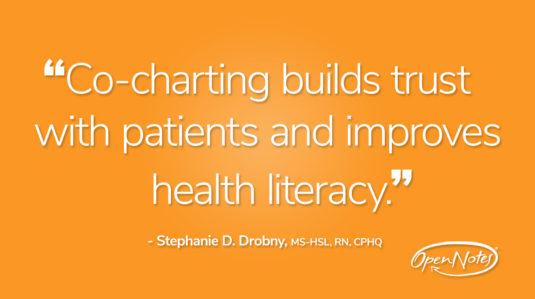
by Stephanie D. Drobny, MS-HSL, RN, CPHQ
This form of team charting builds trust with patients and improves health literacy.
DENVER, CO – Nurses know that real-time charting is widely considered to be best practice. While the usefulness of the practice isn’t disputed, it can be a challenge to balance giving attention to charting with building a relationship of trust with our patients.
Connecting in a relationship of trust requires clear and transparent communication. In 2013, I had a patient who taught me the importance of transparency. When he grumbled that he didn’t trust nurses because they were always talking behind his back, it took me a moment to realize he was referring to my charting process. The idea that charting about a patient in his presence would be perceived as secretive or alienating had never occurred to me.
I quickly thought through everything I knew about protected health information, policy, and the legal ramifications of showing an assessment to a patient. I’d never seen it done, but it was obvious that I needed to take a different approach. Typically, I sat at the bedside, facing the patient, with my workstation on wheels by the patient’s head facing me. I decided to flip the orientation so that I sat side by side with the patient, both of us focused on the computer.
Together we went through the assessment as laid out in the electronic health record, system by system, and entered the responses together. We spent 20 minutes in dialogue about his illness. His questions indicated that being a part of the assessment process was improving his health literacy by helping him “obtain, process, and understand health information,” as described in the Healthy People 2020 initiative. As we spent time charting together, I noticed that he’d become a partner in the assessment process instead of its object. Each time I entered his room during that shift, I turned the computer so he could see it. Toward the end of the shift, he began to wave me off, saying, “Don’t worry about showing me. I trust you.”
Charting as a team with patients became my practice after this. It was remarkable how much faster I was able to earn their trust through this simple collaborative approach. Occasionally a patient would ask me to review the orders for the day. This helped us establish the plan for the day and provided common goals. Sometimes I was asked to go over lab tests or other results, but I was careful not to step outside my scope of practice, always clearly explaining my role as a nurse: to assess the patient, provide information to the physician, and assist the patient to achieve independence as quickly as possible. Few patients asked me to function outside of these parameters once I’d explained my role.
Administrators were hesitant at first about my use of team charting because they had no exposure to it. Once they spoke with patients and received positive feedback, they encouraged me to continue the practice and to present components of team charting at staff meetings.
Three years after I began team charting, I learned of OpenNotes, a movement to open nursing and physician notes to patients begun by the Robert Wood Johnson Foundation in 2010. The concept, as described by the chief executive officer of a large health system and quoted by Bell and colleagues in the August 2015 Joint Commission Journal on Quality and Patient Safety, takes “the caregiving from us being active and patients being passive, to patients being active and us being mentors.”
Charting as a team will not work with every patient, yet in the vast majority of patients it does. Although it requires the nurse to spend roughly 20 to 30 minutes during the initial assessment, engaging patients as active participants in the assessment process improves not only the nurse–patient relationship but the health literacy of our patients. Let’s stop unintentionally objectifying our patients and instead empower them with the knowledge they need to take charge of their health.
Stephanie D. Drobny, MS-HSL, RN, CPHQ is the northern Colorado senior manager for outpatient oncology and infusion at Banner Health.
This post is re-blogged with permission by the author. It originally appeared in the American Journal of Nursing.





You must be logged in to post a comment.